Any dog, regardless of breed, has the potential to bite. Biting is a form of aggression. Aggression can occur when a dog’s emotional state is negative, such as when they are feeling fearful, anxious or frustrated.
Most aggression comes from fear. Dogs use aggression to try to increase the distance between them and a perceived threat.

Signs a dog may get aggressive
Before biting, dogs will often tell us they are afraid or uncomfortable. They do this through their body language.
- Early warnings typically include yawning, lip licking and tail lowering. Their muscles will be tense, and they may turn their head to the side and show “whale eye” (the whites of their eyes).
- If they continue to feel threatened, their warnings may escalate. They may raise their hackles (the hair along their neck and back), lift their lip, growl, and lunge or snap.
Dogs who were not socialized as puppies, who have had negative experiences or who have anxious personalities are more likely to be fearful and possibly bite.
Things that can trigger aggression or make aggression more likely include:
- Objects or situations that cause fear, including unfamiliar things and people
- Desire to guard territory (property) or resources (like people, food or toys), which can be heightened when on leash with no perceived opportunity to escape
- Pain or illness
- Not being neutered
- Negative association with punishment-based training or previous experiences
Learn about training an aggressive dog.

Breed-specific laws (BSL) don’t keep communities safe
The best municipal bylaws are based on the evidence of what actually causes aggression. They offer licensing-discount incentives for owners who go through training and neuter their dogs. Aggressive behaviour, rather than a specific breed, is identified and addressed, resulting in a safer community.
Want to change your community’s bylaws on dangerous dogs?
- Read our position statement on dangerous dogs and public safety.
- Research your municipal bylaw. If you can’t find it through this search, then contact your municipality and ask them to provide you a copy.
- Write a letter asking your municipality to remove breed-specific language in the bylaw and to adopt language that provides for better public safety. Recommend the BC SPCA’s model animal bylaws.
